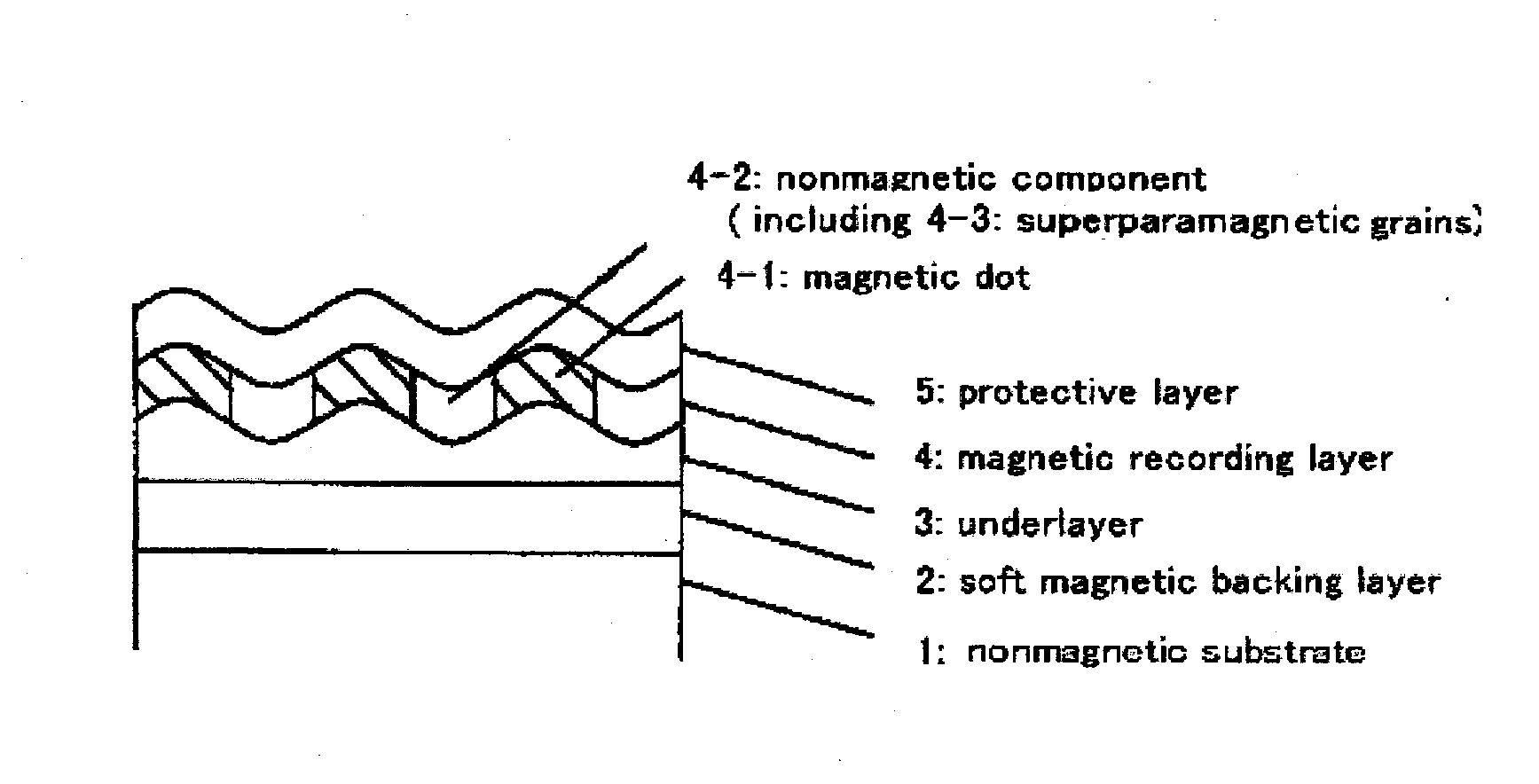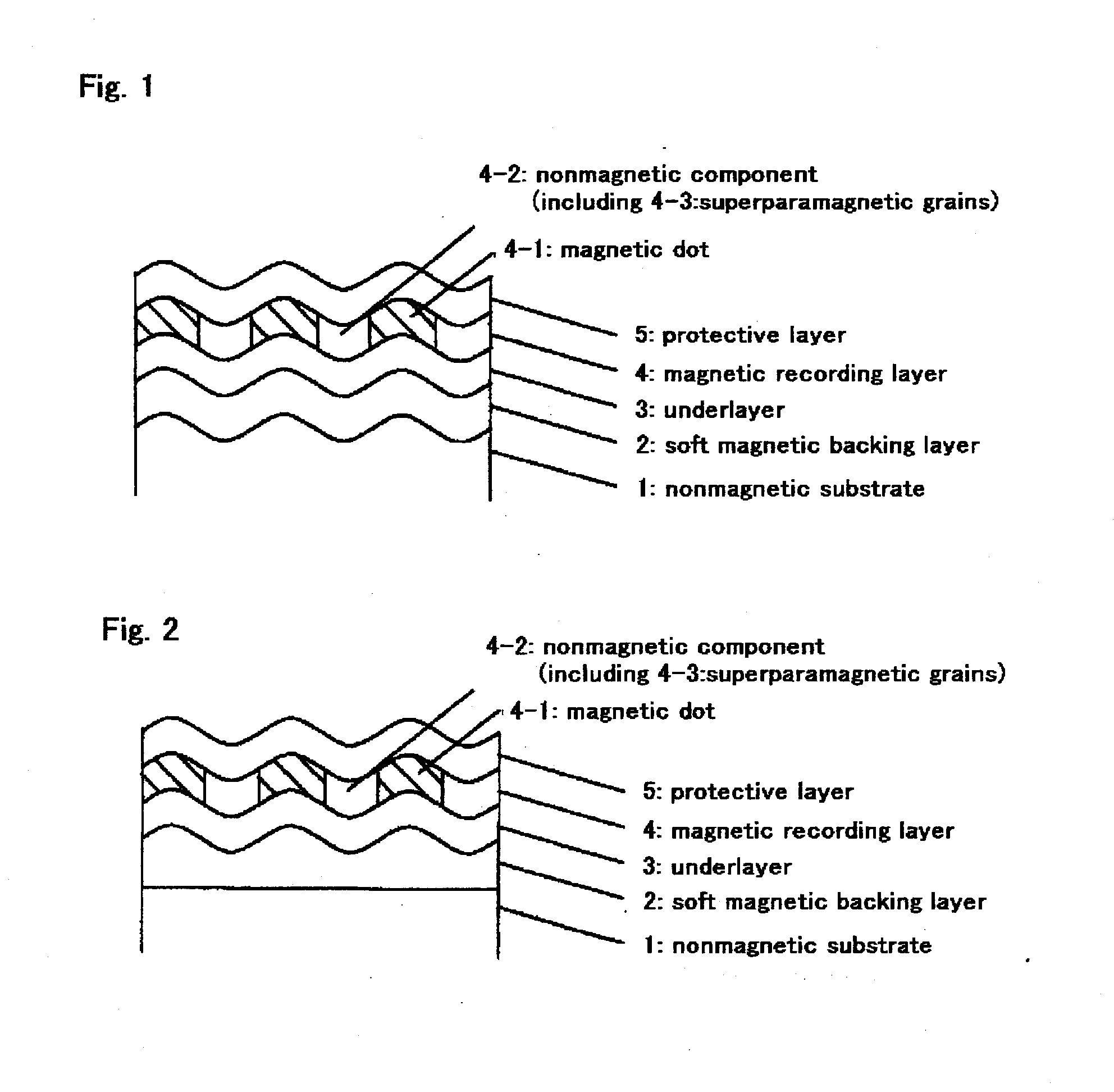Magnetic recording medium and a method of manufacturing the same
a technology of magnetic recording media and manufacturing methods, which is applied in the field of magnetic recording media, can solve the problems of significant degradation of signal quality, form and arrange dots, and difficulty in regularly arranging dots in circumferential and radial directions. achieve the effect of high density recording
- Summary
- Abstract
- Description
- Claims
- Application Information
AI Technical Summary
Benefits of technology
Problems solved by technology
Method used
Image
Examples
example 1
[0049]Nonmagnetic substrate 1 was a silicon substrate in a disk shape with a smooth surface of a surface roughness Ra=0.5 nm. After cleaning, the substrate was introduced into an EB apparatus and line processing was conducted on the substrate surface. The processing was carried out fixing the position of the electron beam and moving the substrate horizontally in the radial direction while rotating the substrate to make concentric circles. The distance between the ridge lines was controlled to 25 nm and the difference in height between top and bottom lines of the undulating structure was controlled to 10 nm. Then, the substrate was introduced into a sputtering apparatus and soft magnetic backing layer 2 of amorphous CoZrTa was formed to a thickness of 100 nm using a target of Co92Zr5Ta3 under an argon gas pressure of 5 mTorr. Subsequently, ruthenium underlayer 3 having a thickness of 5 nm was deposited using a ruthenium target under an argon gas pressure of 3 mTorr. Then, magnetic re...
example 2
[0050]Nonmagnetic substrate 1 used was the same as that in Example 1. After cleaning, the substrate was introduced into a sputtering apparatus and soft magnetic backing layer 2 of CoZrTa having a thickness of 100 nm was formed in the same manner as in Example 1. Introducing the substrate into an EB apparatus, a line processing was conducted on the surface of soft magnetic backing layer 2. Concentric circles were formed in the line processing in the same manner as in Example 1. The distance between the ridge lines was controlled to 25 nm and the difference in height between top and bottom lines of the undulating structure was controlled to 3 nm. After that, ruthenium underlayer 3, magnetic recording layer 4 of CoPt—SiO2, carbon protective layer 5, and a liquid lubricant layer were sequentially formed in the same manner as in Example 1. Thus, a magnetic recording layer of Example 2 was manufactured.
example 3
[0051]Nonmagnetic substrate 1 used was the same as that in Example 1. After cleaning, the substrate was introduced into a sputtering apparatus and soft magnetic backing layer 2 of CoZrTa having a thickness of 100 nm and ruthenium underlayer 3 having a thickness of 5 nm were formed in the same manner as in Example 1. Introducing the substrate into an EB apparatus, a line processing was conducted on the surface of ruthenium underlayer 3. Concentric circles were formed in the line processing in the same manner as in Example 1. The distance between the ridge lines was controlled to 25 nm and the difference in height between top and bottom lines of the undulating structure was controlled to 3 nm. After that, magnetic recording layer 4, protective layer 5, and a liquid lubricant layer were sequentially formed in the same manner as in Example 1. Thus, a magnetic recording layer of Example 3 was manufactured.
PUM
| Property | Measurement | Unit |
|---|---|---|
| grain size | aaaaa | aaaaa |
| grain boundary width | aaaaa | aaaaa |
| size | aaaaa | aaaaa |
Abstract
Description
Claims
Application Information
 Login to View More
Login to View More - R&D
- Intellectual Property
- Life Sciences
- Materials
- Tech Scout
- Unparalleled Data Quality
- Higher Quality Content
- 60% Fewer Hallucinations
Browse by: Latest US Patents, China's latest patents, Technical Efficacy Thesaurus, Application Domain, Technology Topic, Popular Technical Reports.
© 2025 PatSnap. All rights reserved.Legal|Privacy policy|Modern Slavery Act Transparency Statement|Sitemap|About US| Contact US: help@patsnap.com



